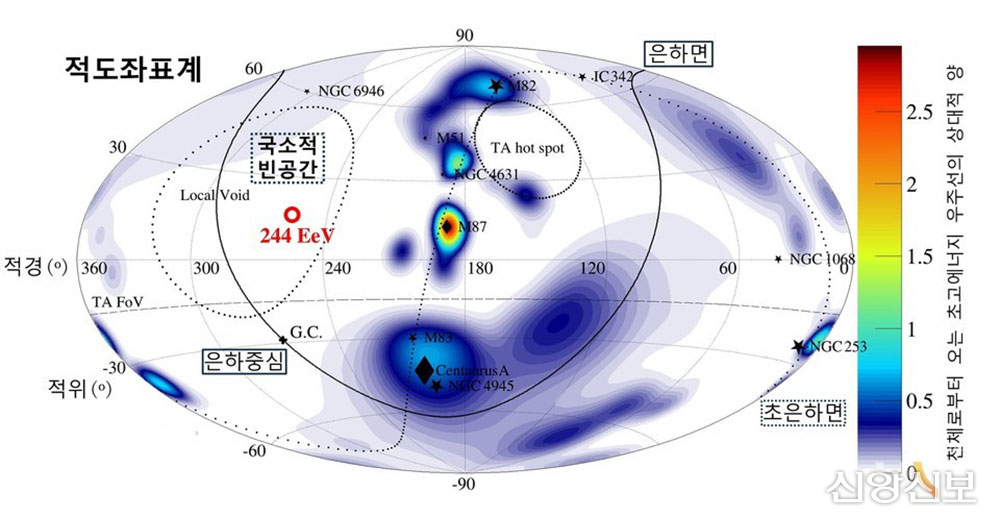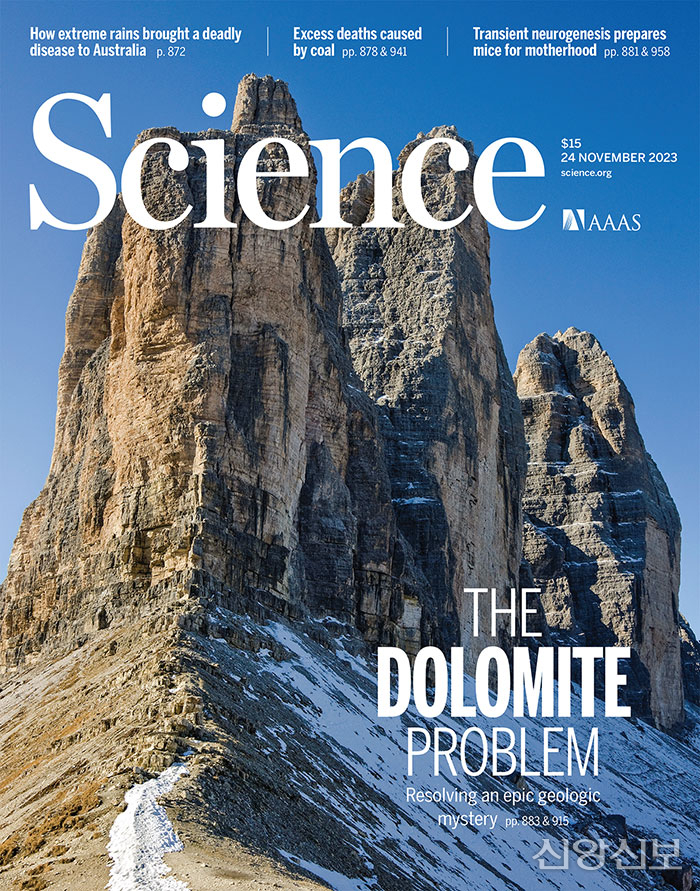[우주로 한 걸음] 출처 불명 초고에너지 우주선(cosmic ray) 포착… 현대 물리학으론 설명 불가
우주는 그 광대함만큼이나 끝없는 미스터리로 가득 차 있습니다. 미스터리를 풀어내는 것은 새로운 진실을 찾아내는 과정입니다. 최근 우주과학계에는 정설로 받아들이던 이론에 어긋나는 미스터리한 결과들이 잇따라 발견되고 있습니다. 작년, 제임스 웹 우주망원경이 초기 우주로 알려진 곳에서 존재할 수 없는 거대 은하를 발견한 데 이어, 지난달에는 기존 이론의 한계를 뛰어넘는 초고에너지 우주방사선이 발견되었다는 논문이 발표되었습니다.
『우주로 한 걸음』에서는 위와 관련된 논문 두 가지를 소개하고자 합니다. 언론에 보도된 내용과 논문의 내용을 일부 발췌하여 실었으며, 지면 관계상 전문은 논문 제공 웹사이트로 이어지는 큐알코드 첨부로 대신하였습니다.
출처 불명 초고에너지 우주선(cosmic ray) 포착…
현대 물리학으론 설명 불가
이론상 존재 불가능한 우주방사선이 발견되다.
지난달 24일, 과학 저널 ‘사이언스(Science)’에 현대 물리학 이론으로는 설명할 수 없는 초고에너지 ‘우주선(宇宙線, Cosmic Ray)’이 발견되었다는 논문이 게재되었다. 논문에 따르면 2021년 5월 27일 포착된 우주선 입자들의 운동에너지가 244 EeV(244×1018eV)에 달하는 것으로 밝혀졌다. 우리 눈에는 보이지 않지만, 우주에서는 고에너지 입자들이 지구를 향해 끊임없이 쏟아져 들어오고 있다. 그중 1 EeV 이상의 에너지를 갖는 우주선을 ‘초고에너지 우주선(UHECR: Ultrahigh-energy cosmic rays)’이라고 하는데, 이조차 흔하게 관측되지 않으며, 이론적으로 가능한 최대 에너지의 한계는 50 EeV이다. 그런데 이번에 발견된 우주선은 이 한계를 아득히 뛰어넘은 것이다.
어떻게 발견되었나
이를 발견한 것은 텔레스코프 어레이(Telescope Array) 국제 공동 연구단으로, 2008년부터 초고에너지 우주선을 관측해 온 기관이다. 우주선이 대기권에 들어오면 대기와 충돌하며 수많은 입자가 생성되는데 이때 발생한 입자들의 비율을 관측해 에너지의 크기를 측정한다.
<그림1> 연구팀은 미국 유타주 서부 사막 700 km2 면적에 입자 검출기 507개를 일정 간격으로 배열해 설치하였는데, 이번에 발견한 우주선은 북서쪽 부분 검출기 23개, 48 km2의 면적에서 포착되었다고 한다. 이를 발견한 일본 오사카 공립 대학교의 천문학자 토시히로 후지이 박사는 전례 없는 고수치에 “처음에는 소프트웨어에 버그가 발생했거나 단순한 관측 오류라고 생각했지만 오류가 아니었다”고 얘기했다. 연구단은 일본 태양의 여신 이름을 따 이 우주선을 ‘아마테라스 입자’로 명명했다.
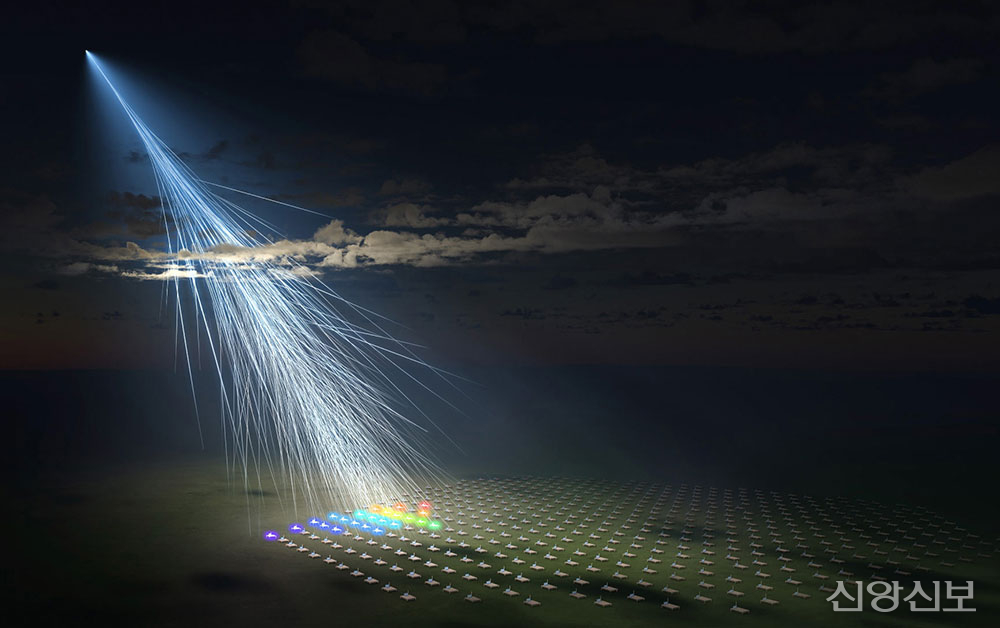
<그림1> 아마테라스 입자와 대기권 입자들의 충돌을 구현한 상상도
초고에너지 우주 방사선인 ‘아마테라스 입자’는 지구 대기권 진입 후 대기의 분자들과 충돌해 수천억 개 이상의 2차 입자를 형성한다. 그림은 지표면에 있는 입자 검출기가 2차 입자들을 포착하고 있는 모습이다. (출처: 교토대학교·텔레스코프 어레이 공식 홈페이지)
이런 발견이 처음이 아니다
그런데 이렇게 강력한 우주선이 관측된 것은 이번이 처음이 아니다. 아마테라스 입자가 발견되기 30년 전인 1991년, 유타대의 ‘플라이아이(Fly’s Eye)’ 실험에서 320 EeV의 에너지를 가지는 우주선이 관측되었다. 당시 천체 물리학자들은 충격에 빠졌고, 이 입자를 오마이갓 입자(oh my God particle)라고 명명했다. 오마이갓 입자가 발견된 이래로 1993년에 213 EeV, 2001년에 280 EeV의 에너지를 가진 우주선들이 관측된 바 있다.
우주선의 출처도 모른다
초고에너지 우주선은 저에너지 우주선과 달리 주변 자기장의 영향을 받지 않아 우주를 직선으로 이동한다. 따라서 관측 방향으로 역추적하면 초신성 폭발이나 블랙홀 등 어떤 천체로부터 기원된 건지 그 출처를 알아낼 수 있다. 그러나 연구진은 아마테라스 입자가 날아온 방향에는 근원 은하나 잠재적 출처가 될 만한 다른 알려진 천체가 전혀 없었다며, 우주선이 온 방향은 우주 거대 구조에서 은하가 거의 존재하지 않는 빈 공간 영역(Local Void)를 가리키고 있다고 밝혔다. 이는 오마이갓 입자도 마찬가지였다.
연구진은 이런 현상에 대한 설명으로 은하 자기장 모델에서 예측하는 것보다 더 큰 자기 편향이 존재할 가능성이나 지역 외부 은하 인근에 미확인 발생원이 있을 가능성 등이 있지만 현재의 입자 물리학으로는 설명할 수 없다는 것은 분명하다고 말했다.
언제 어디서 어떻게 만들어진 것인지 알 수 없는 우주선들의 존재는 물리학계의 새로운 난제가 되었다. 과학자들은 존재 자체가 미스터리인 초고에너지 입자들의 존재가 현대 물리학의 불완전성을 보여주는 사례로 보고 있다.
연구논문 RESEARCH ARTICLE
지표면 검출기 어레이로 관측된 초고에너지 우주선 / An extremely energetic cosmic ray observed by a surface detector array
November 2023 Science 382(6673):903-907
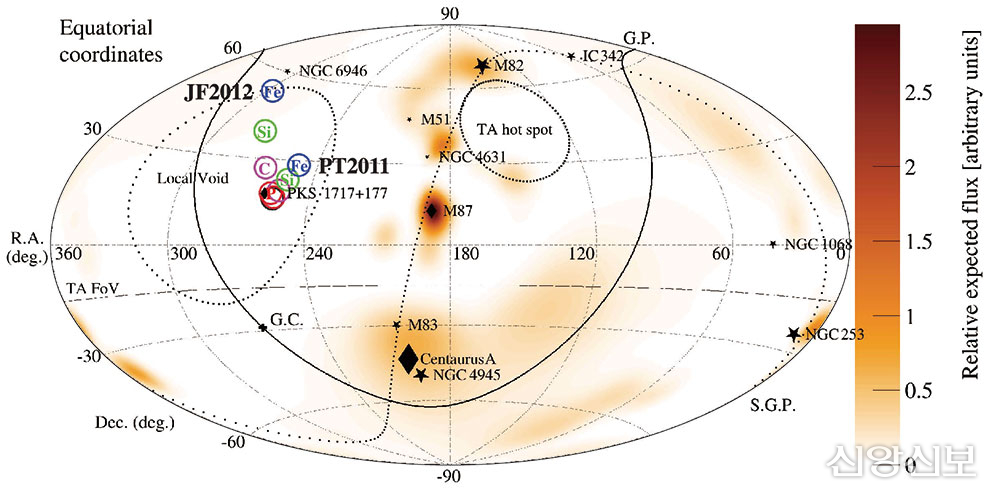
▲ [그림 2] 고에너지 이벤트 도착 방향을 잠재적 근원과 비교
적도 좌표 천체 지도에서 2021년 5월 27일 고에너지 우주선 입자(블랙 입자) 도착 방향. 색의 원은 일반 자기장 은하의 두 모델을 가정하여 도착 방향의 역추적을 계산. JF2012 그리고 PT2011로 레이블표시. 각 모델에 대해서 다양한 기호가 가능한 1차 종에 대해 계산된 방향을 보여준다. 양성자(P; 적색), 탄소(C; 자주색), 규소(Si; 녹색), 철(Fe; 청색). 색이 있는 막대는 일부 LSS에서 비균질 근원으로부터 기대되는 상대 플럭스(은하 자기장으로 번지는 일부 LSS에서 밀도 분포)를 나타낸다. 비교를 위해 감마선을 발산하는 근처의 은하핵을 검은색 마름모로 표시한다. 그리고 근처 폭발적 항성 생성은 검은색 별 모양으로 표시한다. 모두 예상되는 플럭스에 따라 조정된 크기를 갖는다. 감마선 근원 카탈로그에서 방향을 역추적한 양성자에 가장 가까운 물질은 활동성 은하 PKS 1717+177이다. (출처: 사이언스지)
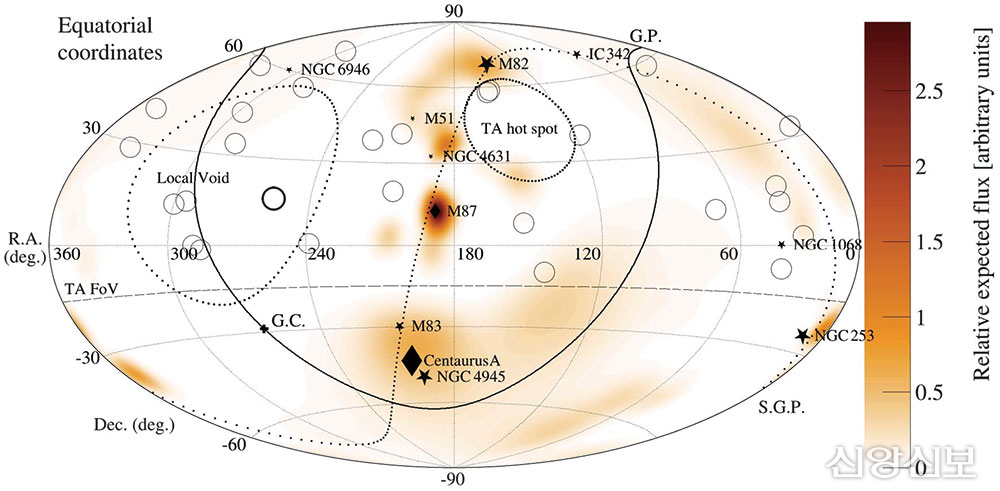
▲ [그림 3] 극단적 초고에너지 우주선 발생 지점 추정 위치
텔레스코프 어레이 검출기(TA SD)가 13.5년간 포착한 에너지 수준 100 EeV 이상의 초고에너지 우주선(UHECRs)이 날아온 방향을 토대로 추정한 발생 지점(작은 검은색 원들). 짙은 검은색 원은 ‘아마테라스 입자’의 발생 추정 지점. 대부분의 추정 지점에 초고에너지 우주선을 방출할 만한 은하나 발생원이 없다. (출처: 사이언스지)
초록 Abstract
우주선(宇宙線, cosmic ray)이란 외계의 근원으로부터 날아온 고에너지 하전 입자들로, 은하계 밖에서 기원한 것으로 판단되는 고에너지 이벤트를 발생시킨다. 이들이 지상에 도달하는 경우는 드문 경우여서 이를 검출하기 위해서는 넓은 수집 면적을 가진 계측기가 필요하다. 본 논문은 텔레스코프 어레이 실험의 지표면 검출기 어레이에 의해 기록된 초고에너지 입자의 검출을 보고한다. 우리는 입자의 에너지를 244 EeV(~40 joules)로 계산한다. 이 입자의 도착 방향을 역추적하면 우주 구조의 거시공동(巨視空洞, void)을 향한다. 이에 대한 가능한 설명은 전방 자기장에 의해 발생한 대규모 휘어짐, 은하계 외부에 있는 근원, 입자 물리학의 불완전한 지식 등이다.
초고에너지 우주선(UHECRs)은 인공 입자 가속기로 도달할 수 있는 에너지의 약 백만 배가 되는 1 EeV (=1018eV) 이상의 에너지를 갖는 아원자 입자들이 은하계 외부의 근원으로부터 날아온 것이다. UHECRs의 근원은 블랙홀, 감마선 폭발, 활동성 은하핵의 상대론적 플레어, 은하단 주변 거대규모 강착 충격과 연관된 상대론적 제트와 분출류 등, 우주에서 가장 에너지가 높은 현상과 관련된 것으로 판단된다.
텔레스코프 어레이 실험
100 EeV 이상의 에너지에서, 우주선 플럭스는 km2당 100년에 하나의 입자보다 작다. 이렇게 낮은 플럭스는 대략 1000 km2의 넓이의 수집 영역이 있는 계측기로만 측정될 수 있다. UHECRs의 에너지, 질량, 도착 방향은 지구의 대기권 진입 시 상호작용으로 생성되는 2차 입자[광역 대기 샤워(extensive air shower, EAS)]의 연쇄반응(cascade)으로부터 재구성될 수 있다. 플라스틱 섬광기 혹은 워터-체렌코프 스테이션 같은 검출기의 배열은 입자들이 지상에 도달했을 때 EAS를 측정할 수 있다.
텔레스코프 어레이 (TA) 실험은 미국 유타주에 북위 39.30°, 서경 112.91° 그리고 해발 1370 m에 위치한 우주선 검출기이다. 이것은 정사각형 격자에 배열된 507개의 스테이션을 갖는 지표면 검출기 (surface detector, SD) 어레이로 구성된다. 각각의 검출기에는 하전 EAS 입자를 검출하는 두 겹의 3m2 플라스틱 섬광 검출기가 있다. 이 스테이션들은 1.2 km의 간격을 두고 700 km2의 총 유효 면적에 걸쳐 있다. 뮤온과 전자의 검출에 의해서 지표면 검출기의 시간에 따른 반응이 계속적으로 감시되고 보정된다. SD 위의 하늘이 형광 검출기(fluorescence detector, FD)에 나타난다. 이렇게 해서 대기를 통해 EAS의 전파(propagation)에 의해서 생성된 광자를 직접적으로 측정한다. 이로써 이 EAS의 에너지 열량을 측정한다.
2021년 5월 27일의 고에너지 입자
2008년 5월과 2021년 11월 사이에 얻어진 모든 SD 데이터의 도착 방향 분석 중에 이례적으로 높은 에너지 이벤트를 발견하였다. 이 이벤트는 TA SD의 서북 지역에서 23개의 검출기를 작동하게 했다. 분석 절차 후에, 2021년 5월 27일의 이벤트가 검출기의 프레임에서 244 EeV의 재구성된 에너지 값을 갖는 것을 확인했다.
이전 이벤트와의 비교
이전에 보고된 초고에너지 우주선은 1991년 320 EeV 입자, 1993년 213 EeV 입자, 2001년에 280 EeV 입자가 포함된다. 1991년 이벤트는 형광 검출기를 사용하여 측정된 반면 1993년과 2001년 이벤트는 모두 지표 검출기 배열을 통해 검출되었다. 이 모든 이벤트는 북반구의 검출기에 의해 기록되었다. 실험들 사이에 에너지 척도가 다르지만, 남반구에서의 탐색으로는 에너지가 166 EeV보다 큰 어떤 이벤트도 찾을 수 없었다, 우리가 검출한 이벤트는 지표 검출기 배열로 측정되었지만 244 EeV의 보고된 에너지는 TA 형광 검출기를 가지고 측정된 동등한 에너지로 표준화되어 1991년 이벤트와 직접 비교할 수 있다. 표준화되지 않은 TA SD 재구성 에너지 309 EeV는 1993년과 2001년 사건들과 비교하는 데 더 적합하다
우주선의 가능한 근원
그림 2는 천문학 적도 좌표의 천체지도에 2021년 5월 27일 이벤트의 도착 방향의 계산을 보여준다. 도착 방향은 은하 자기장이 244 EeV의 에너지를 갖는 입자를 상당히 휘도록 만드는데 충분히 강한 은하 원반으로부터 멀지 않다. 특히 1차 원자가 큰 대전하를 갖는 중핵자일 경우 더욱 그렇다. 이 지도는 또한 8개의 가능성 있는 도착 방향을 보여준다. 이는 우리가 은하자기장(galactic magnetic field, GMF) 모델 그리고 네 개의 가능성 있는 1차 입자(양자, 탄소 핵, 실리콘 핵, 철 핵)로 계산하였다. 우리는 우주선 전달 프레임워크의 역추적 방식을 사용하여 은하수로 들어가기 전에 우주선에 대한 도착 방향을 결정하였다.
다른 TA 이벤트의 분포
그림 3은 2008년 5월과 2021년 11월에 선정된 동일한 이벤트를 사용하여 관찰된 100 EeV 이상의 에너지를 가진 28건의 TA SD 이벤트에 대한 도착 방향을 보여준다. 가장 높은 에너지를 가진 클러스터는 없었다. 100 EeV 이상의 에너지를 갖는 이벤트에서 클러스터가 형성될 것이라고 예상했음에도 불구하고, 관찰된 100 EeV 이상의 도착 방향은 등방성 분포를 나타낸다.
244 EeV 이벤트의 근원의 부족은 무거운 1차 입자 혹은 모델보다 더 강한 자기장으로 인해 일어나는 GMF에 의해 예측된 것보다 더 큰 자기 편향 때문일 수 있다. 또한, 초-GZK UHECR은 입자 물리학의 불완전한 이해를 보여주는 것일 수 있다.
요약 및 결론
244 EeV의 에너지를 갖는 입자를 2021년 5월 27일 검출했다. 이 이벤트의 도착 방향은 다양한 가정하에 은하자기장에 의한 굴절에 대한 설명 이후에도 UHECRs의 잠재적 근원이 될 것으로 판단되는 어떤 알려진 우주 물질과도 일치하지 않는다. 100 EeV 이상의 높은, 고에너지 사건들이 우주의 특정 방향이나 위치에 집중되어 있지 않고, 다양한 방향에서 관찰된다.
Abstract
Cosmic rays are energetic charged particles from extraterrestrial sources, with the highest-energy events thought to come from extragalactic sources. Their arrival is infrequent, so detection requires instruments with large collecting areas. In this work, we report the detection of an extremely energetic particle recorded by the surface detector array of the Telescope Array experiment. We calculate the particle’s energy as 244 EeV(~40 joules). Its arrival direction points back to a void in the large-scale structure of the Universe. Possible explanations include a large deflection by the foreground magnetic field, an unidentified source in the local extragalactic neighborhood, or an incomplete knowledge of particle physics.
Ultrahigh-energy cosmic rays (UHECRs) are subatomic particles from extragalactic sources with energies greater than 1 EeV (equal to 1018 eV), which is about a million times as high as the energy reached by human-made particle accelerators. The origins of UHECRs are thought to be re lated to the most energetic phenomena in the Universe, such as relativistic jets and outflows associated with black holes, gamma-ray bursts and relativistic flares of active galactic nuclei, or large-scale accretion shocks around clusters of galaxies.
The Telescope Array experiment
At energies greater than 100 EeV, the flux of cosmic rays is less than one particle per century per square kilometer. This low flux can only be measured by an instrument with a collecting area of ~1000 km2. The energy, mass, and arrival direction of UHECRs can be reconstructed from the cascades of secondary particles [an extensive air shower (EAS)] produced by their interaction with Earth’s atmosphere. Arrays of detectors, such as plastic scintillators or water-Cerenkov stations, can measure EASs when they reach the ground.
The Telescope Array (TA) experiment is a cosmic-ray detector located in Utah, USA, at 39.30° north, 112.91° west and 1370 m above sea level. It consists of a surface detector (SD) array with 507 stations arranged in a square grid. Each detector has two 3m2 layers of plastic scintillator that detect charged EAS particles. The stations are spaced by 1.2 km, giving a total effective area of 700 km2. The time dependent response of the surface detectors is continuously monitored and calibrated by the detection of penetrating muons and electrons. The sky over the SD is viewed by fluorescence detectors, which directly measure photons produced by the propagation of an EAS through the atmosphere, providing a calorimetric measurement of the shower energy.
Energetic particle on 27 May 2021
An unusually high-energy event was identi- fied during an arrival direction analysis of all SD data taken between May 2008 and November 2021. This event triggered 23 detectors at the northwest region of the TA SD. Following our analysis procedure, we determined that the event on 27 May 2021 had a reconstructed energy of 244 EeV in the detector frame.
Comparison with previous events
Previously reported extremely high-energy cosmic ray events include a 320 EeV particle in 1991, a 213 EeV particle in 1993, and a 280 EeV particle in 2001. The 1991 event was measured using fluorescence detectors, whereas the 1993 and 2001 events were both detected using surface detector arrays. All of these events were recorded by detectors in the Northern Hemisphere. A search in the Southern Hemi-sphere has not identified any events with energy greater than 166 EeV, although there is an energy scale difference between the experiments. Although the event that we have detected was measured with a surface detector array, the reported energy of 244 EeV has been normalized to the equivalent energy that would have been measured with the TA fluorescence detector and is thus directly comparable to the 1991 event. The unnormalized TA SD reconstructed energy of 309 EeV is more appropriate for comparison with the 1993 and 2001 events.
Possible sources of the cosmic ray
Figure 2 shows the calculated arrival direction of the 27 May 2021 event on a sky map in equatorial coordinates. The arrival direction is not far from the disk of the Milky Way, where the galactic magnetic field (GMF) is strong enough to substantially deflect even a particle with an energy of 244 EeV, especially if the primary particle is a heavy nucleus with a large electric charge. The map also shows eight possible backtracked arrival directions, which we calculated by assuming two GMF models and four possible primary particles (proton, carbon nucleus, silicon nucleus, or iron nucleus). We used the backtracking method of a cosmic-ray propagation framework to determine the arrival direction for the cosmic ray before it entered the Milky Way.
Distribution of other TA events
Figure 3 shows the arrival directions for the 28 TA SD events with energies >100 EeV observed between May 2008 and November 2021 using the same event selection. No clustering with the highest-energy event is found. Although we expected events with energies above 100 EeV to be clustered, the observed arrival directions above 100 EeV have an isotropic distribution.
The lack of a nearby source for the 244 EeV event could be due to larger magnetic deflections than predicted by the GMF models, caused by a heavy pri mary particle or stronger magnetic fields than in the models. Alternatively, super-GZK UHECRs could indicate an incomplete understanding of particle physics.
Summary and conclusions
We detected a particle with an energy of 244 EeV on 27 May 2021. The arrival direction of this event does not align with any known astronomical objects thought to be potential sources of UHECRs, even after accounting for deflection by the GMF under various assumptions. Comparison with other observed events at energies above 100 EeV shows an isotropic distribution with no apparent clustering.

